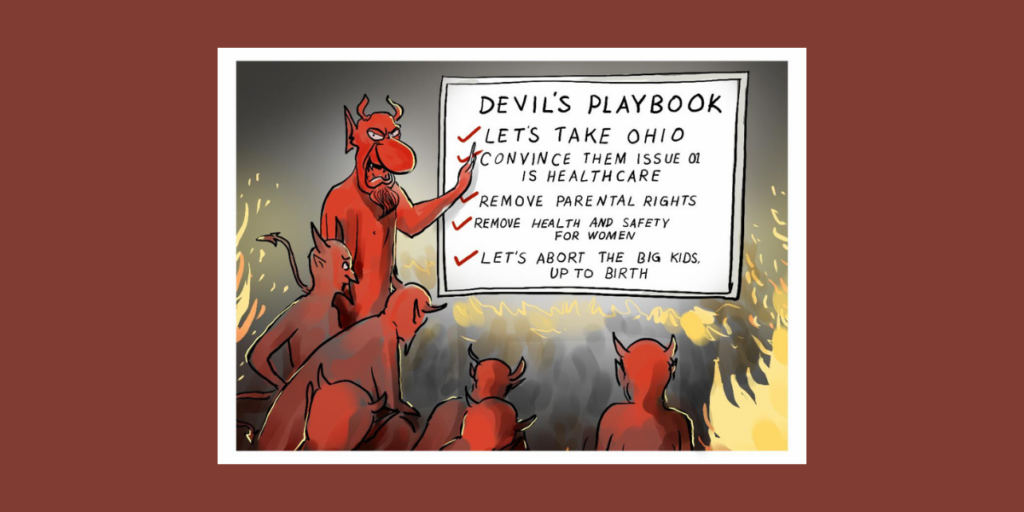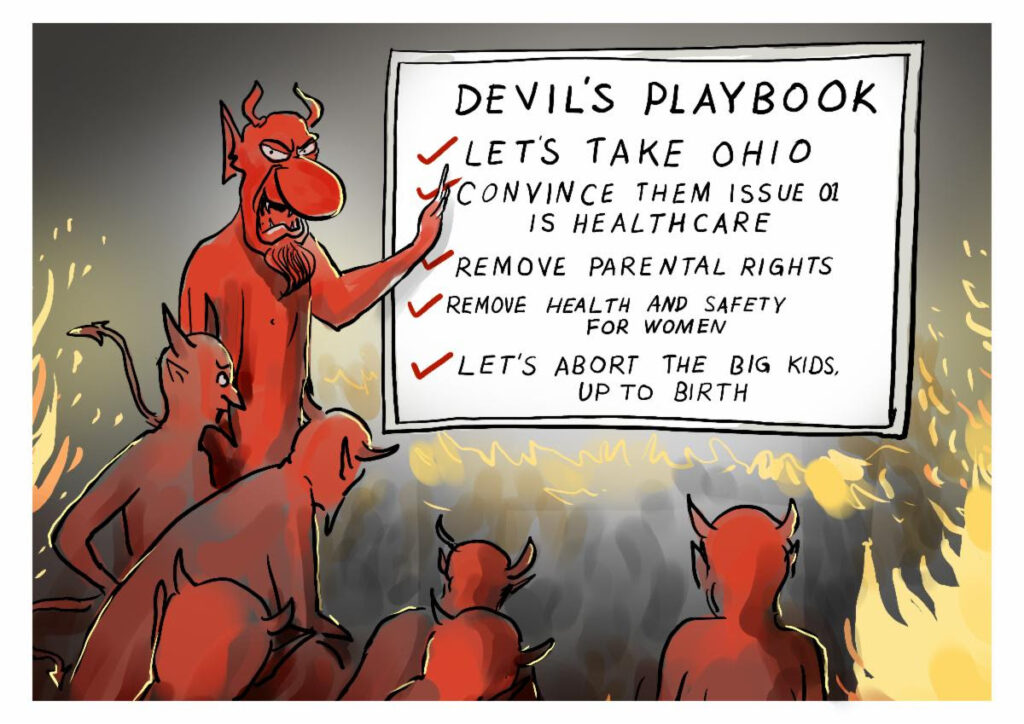
Major news outlet helping spread misinformation by Ohio Issue 1 backers, here’s the truth
The day early in-person voting started in Ohio a report was released assigning misinformation largely to opponents of Issue 1, failing to report false claims by Issue 1 backers.
By Jack Windsor of The Ohio Press Network
Despite what the Associate Press (AP) report stated:
- Standard miscarriage and ectopic care are legal and will still be legal and provided to standard if Issue 1 is rejected.
- Abortion permissions exist that protect a mother’s life and major health functions even if Ohio’s heartbeat law is in effect.
- Three legal experts cited in the AP report have contributed over 340 times to Democrats.
- Issue 1 abortion permissions go beyond Roe v. Wade rules.
- Three-fifths of abortions involve women who report being coerced, raising concern that unlimited abortion rules may protect sex traffickers and abusers.
- Infanticide does occur in places where it’s both legal and illegal and may be permitted if Issue 1 passes.
- If the term “individual” in the proposed amendment is interpreted to include minors, gender transitions without burden (read: parental consent) may happen.
- Ohio AG Yost’s legal opinion states that parental rights are not guaranteed if Issue 1 passes—opening the door to minor abortions and gender transitions without parental involvement.
The Full Story
Ohioans will cast their final ballots in person on Election Day either for or against Issue 1 in just 10 days. Proponents say the proposed constitutional amendment simply codifies Roe v. Wade abortion rules, protecting a woman’s reproductive health. Opponents vehemently argue Issue 1 goes beyond Roe, aiming for abortion up to the time of birth for matters of convenience while allowing minors to abort pregnancies and gender transition without parental involvement.
Both sides accuse the other of misinformation. The day early in-person voting began in Ohio the Associated Press (AP) released a story headlined “Ohio Votes on Abortion Rights This Fall. Misinformation About the Proposal is Spreading.”
Last week results from a poll revealed Americans whose trust level is “none at all” in media recorded an all-time high. However, the AP is frequently atop the list of news outlets that garner the most trust.
However, the AP report failed to fact-check misinformation backers of Issue 1 continue to spread and didn’t push back on claims such as:
• Abortion limits won’t extend beyond Roe permissions if Issue 1 passes
• Abortions aren’t coerced
• Infanticide doesn’t happen
• Minor gender transitions have nothing to do with Issue 1
• Parents won’t lose rights if Issue 1 passes
Legal experts referenced in the AP article have contributed over 340 times to Democrats statewide and in national races. Additionally, several statements and allegations also went unchecked – the pushback to those statements and allegations are below.
Misinformation from Issue 1 backers outlets should be fact-checking Issue 1 backers say that current Ohio law doesn’t provide care for women experiencing miscarriage or ectopic pregnancies.
Current Ohio law protects women experiencing these serious medical conditions. A group of Ohio board-certified OB/GYN’s called out the medical misinformation included in an Issue 1 ad. One doctor stated, “there is no law in Ohio that stops us from…caring for mom during an emergency such as an ectopic pregnancy or miscarriage.”
Even the Ohio Department of Health refutes the false claim in a letter stating that current state laws and regulations “do not in any way hinder the provision of ‘emergency care for miscarriages.’”
Issue 1 backers claim the heartbeat law doesn’t have exceptions for the life of the mother. This is false. The heartbeat law is under permanent injunction by Hamilton County Judge Christian Jenkins in a lawsuit brought by ACLU of Ohio. A left-leaning Cleveland news outlet article criticized opponents of Issue 1 who claim that the current permission for abortion in Ohio extends to 22-weeks—which is a true claim.
Nonetheless, the heartbeat law does include exceptions for the life and healthy bodily function of the mother as Ohio Attorney General Dave Yost explained in his legal analysis of Issue 1.
Late-Term Abortions
The AP article states:
…opponents of the measure argue that the proposal would still allow for abortions ‘up to birth’ because it lets doctors decide when a fetus is viable or not and because it has an exemption allowing later abortions to protect the life or the health of the mother. Independent medical and legal experts say this argument discounts that doctors have a duty to follow medical science.
Pushback:
• Issue 1 contains a major loophole: the amendment allows for late-term abortions to protect the “health” of the mother; however, “health” is not defined in the amendment. When left undefined, the United States Supreme Court has interpreted “health” to include not just a mother’s physical health, but also her mental health, financial health, emotional health and social health. Essentially, late-term abortions could be permitted for any reason.
The AP article states:
Abortions later in pregnancy are exceedingly rare. In 2020, less than 1% of abortions in the United States were performed at or after 21 weeks, according to the federal Centers for Disease Control and Prevention.
Pushback:
• Over 50,000 abortions are performed annually in the U.S. after 15 weeks of gestation when unborn babies can feel pain, and at least 10,000 are performed after 20 weeks.
• Protect Women Ohio, the group supporting a “no” vote on Issue 1, highlighted the fact that Issue 1 will permit painful, late-term abortions in Ohio in a recent ad featuring Ohio abortionist Martin Haskell. Haskell invented the barbaric partial-birth abortion technique in Ohio, and brags that he “routinely” performs late-term abortions at 20-24 weeks, even admitting 80% of the partial-birth abortions he performs are “purely elective.” Haskell gave $100,000 to the campaign supporting Issue 1.
• Colorado’s lack of gestational limits has allowed abortionist Dr. Warren Hern to specialize in “late-abortions” for the past five decades, ending the pregnancies of women who are “22, 25, even 30 weeks along…” (A former patient of Dr. Hern admitted to having an abortion at 35 weeks.)
The AP article states:
“The people who are getting abortions later in pregnancy are those who have incredibly heartbreaking situations, either some awful, terrible fetal anomaly that took a while to be diagnosed or some maternal medical condition that puts the mother’s life at risk,” said Mae Winchester, a Cleveland-based maternal fetal medicine specialist.
Pushback:
• The claim that all late-term abortions are “medically necessary” is false. Most late-term abortions are elective, and even the pro-abortion Guttmacher Institute concluded that most women seeking late-term abortion are “not doing so for reasons of fetal anomaly or life endangerment.”
• Abortionist Dr. Martin Haskell (Ohio doctor who performs abortions through 22 weeks in Dayton) has admitted that 80% of the partial-birth abortions he performed were “purely elective.” He has claimed the other 20% were because the child had a genetic abnormality.
The AP article states:
Experts say the idea of abortions ‘up to birth’ is misleading in itself. Terminations later in pregnancy involve medication that induces birth early, which is different from a surgical abortion.
“Abortion at the time of birth, it’s literally not a thing,” Sarah Prager, a professor of obstetrics and gynecology at the University of Washington, previously told the AP.
Pushback:
• Ohio Doctor Martin Haskell invented the “dilation and extraction” method known as partial-birth abortion. The procedure involved, “Dilating the woman’s cervix, then pulling the fetus through it feet first until only the head remained inside. Using scissors or another sharp instrument, the head was then punctured, and the skull compressed, so it, too, could fit through the dilated cervix.”
• A suite of bills, HB 4949 – HB 4959, was introduced in September 2023 to implement Michigan’s Prop 3. It includes repealing the state’s prohibition of partial-birth abortion.
Coercion
The AP article states:
Abusers do not assist their victims. The idea that an abuser could, by coercing someone to obtain an abortion or to carry a pregnancy to term, somehow be protected or insulated from punishment for that coercion is simply inconsistent with the language of the second provision of the amendment…
Pushback:
• Three out of every five women who have had an abortion report being pressured into it. There are no penalties or even any threat of penalty under this amendment for applying this pressure.
• This has happened in Ohio, when a teenage girl became pregnant by her 21-year-old soccer coach. He pretended to be her father in order for her to get an abortion.
Infanticide
The AP article states:
Numerous legal experts said the answer to those questions [killing or neglecting a living child] is an emphatic no. Infanticide is already illegal in the U.S., they said, and the amendment doesn’t change that.
Pushback:
• An Ohio legal expert stated that the amendment would legitimize abortion without limits and authorize “infanticide on demand.”
• Former Virginia Governor Ralph Northam M.D., known for his opposition for any limits on abortion, has advocated for infanticide.
• Washington D.C.’s late-term abortionist Cesare Santangelo admits to supporting infanticide when babies survive abortions, and five fully-formed babies – possible victims of partial-birth abortions – were found in connection to his Washington clinic just last year.
Gender-Related Healthcare
The AP article states:
The ballot language specifies that it protects reproductive decisions “including but not limited to” contraception, fertility treatment, continuing one’s own pregnancy, miscarriage care and abortion.
Independent legal experts say it’s a stretch to suggest that also means gender-related health care. That legal theory has not been attempted in other states.
Pushback:
• A Statement from Megan M Wold, Ohio Legal expert, former Supreme Court clerk, and former Deputy Solicitor General in the Ohio Attorney General’s Office: “The list of protected reproductive rights is only illustrative, not a limit, so the language will protect other choices related to reproduction, including transgender treatment.”
• An analysis from legal scholars Carrie Campbell Severino and Frank Scaturro show how the amendment will outlaw restrictions on sex-change surgeries.
Parental Consent
The AP article:
The amendment does not change Ohio’s existing parental notification and consent law, which requires minors to have parental permission — or a judicial exception in extreme cases — in order to get an abortion.
Pushback:
• In a legal analysis of Issue 1, Attorney General Yost said that even though the amendment doesn’t specifically address parental consent: “There is no guarantee that Ohio’s parental-consent law will remain in effect.”
• Ohio reporter Laura Hancock agrees, noting that current parental consent laws would end up in court.
The AP article:
“Similar arguments related to parental consent were made ahead of Michigan’s vote last year to codify abortion rights in the state’s constitution,” said Jessie Hill, a law professor at Case Western Reserve University School of Law who serves as a consultant to the Issue 1 campaign.
“None of these things have come to pass,” Hill said.
Pushback:
• Following the passage of Prop 3, Michigan’s informed consent paperwork no longer includes a question about parental consent for minors and Governor Whitmer has referred to parental consent laws and abortion restrictions as “unconstitutional” under Prop 3.
Further than Roe
The AP article states:
Anti-abortion advocates have claimed the proposed measure would go further than Roe v. Wade, making it impossible to pass any abortion restrictions. But legal experts say that is not true and that the amendment uses almost verbatim language from the now-overturned Supreme Court decision that had granted a constitutional right to abortion.
Pushback:
• Ohio Attorney General Dave Yost’s legal analysis: “The proposed Amendment appears to borrow some concepts from the Roe era, but also creates a new, legal standard that goes beyond what Roe and Casey said.”
The legal experts cited in the AP story are not neutral commentators. Three of the experts made significant contributions to Democrat candidates
Dan Kobil – Capital University Law School
• Over 300 donations to Federal campaign committees, almost all to Democrats.
- Donations to Joe Biden, John Kerry, Hillary Clinton, DNC, Tim Ryan, and others.
• Contributed to multiple state level Democrats in Ohio
• Kobil wrote an op-ed stating that abortion bans are akin to government taking a woman’s body as property.
Tracy Thomas – University of Akron
• At least 20 donations to Federal campaign committees, all to Democrats.
- Donations to Biden, Obama, Hillary Clinton, Elizabeth Warren, and others.
Jessie Hill – Case Western Reserve University School of Law
• At least 22 donations to Federal campaign committees, all to Democrats.
- Donations to Hillary Clinton, Obama, DSCC, Sherrod Brown, Tim Ryan, and others.
• Contributed to multiple state level Democrats in Ohio
• Hill is currently arguing against the Heartbeat Bill in court and was a part of drafting Issue
Heartbeat law a red herring
A consistent claim from Issue 1 proponents is that passing the amendment would end the Ohio “abortion ban.”
The longer explanation of that argument is that the amendment would eliminate the heartbeat law—a bill that was signed into law in July 2019 but was later blocked by a federal judge who claimed the law placed an “undue burden” on a woman’s right to choose a pre-viability abortion.
The law prohibited, with exceptions, abortion after a heartbeat is detected in an unborn child. After the Supreme Court of the United States decided in the summer of 2022 that abortion is a states’ rights issue, the law preventing abortion after a heartbeat went back into effect.
That lasted merely 82 days until a Hamilton County Judge Christian Jenkins (a Democrat) blocked the law.
But if technicalities are being examined, even the heartbeat law doesn’t fully ban abortion and a ban wouldn’t exist even if the law were reinstated. Abortion would be permitted up to the heartbeat and after for ectopic pregnancies, threats to the mother’s life and serious risk of substantial, permanent impairment to a major bodily function of the mother.
“No on Issue 1” backers argue that Ohio doesn’t have an abortion ban and by the letter of the law they are correct as abortion in Ohio is legal to 21 weeks and six days.
“Now that they’re trying to convince voters to reject an abortion-rights amendment Nov. 7, they’ve begun to act like it doesn’t exist,” writers for a left-leaning Cleveland news organization wrote days after early in-person voting began.
The writers then go into an explanation that the heartbeat law is still in the books but suspended and that it may go into effect again.
What writers seemingly fail to address is three facts.
First, there is no guarantee the heartbeat law will go back into effect.
Second, even if the heartbeat law does get reinstated, there has already been a call to action from the state’s top Republican: Gov. Mike DeWine. DeWine has asked lawmakers to reexamine the law and consider changes palatable to most Ohioans.
Third, if passed Issue 1 would amend the state constitution. Undoing an amendment is much harder (more time consuming, expensive and challenging) than amending a section of the Ohio Revised Code which is where the heartbeat law is written.
“And what I have said is that I have suggest to members of the state legislature we want to have a bill that protects human life. We also have to have a bill that is sustainable, and that will not be overturned by voters at the polls,” DeWine said.
Editor’s note
Issue 1 may be the most important political decision in a generation. The fact that it seeks to establish abortion rules through a constitutional amendment that doesn’t seem to have been fully examined with respect to its potential outcomes is travesty.
A more appropriate alternative would be creating abortion permissions via the legislative process where lawmakers host proponent and opponent testimony, amend and debate the matter publicly before voting.
Ohio Issue 1 proposed amendment language contains terms such as “individual” (when describing who the amendment applies to), “health” when describing the reasons care providers can abort a pregnancy beyond fetal viability and “burden” when describing the type of interference that is prohibited that could interrupt the execution of an abortion or reproductive care.
When terms are ambiguous and broad in legal language—and not defined—they are left up to interpretation by the judiciary (courts).
If the backers of Issue 1 didn’t want to allow unlimited abortions and sought to protect parents’ rights to intercede on abortion and gender transition care decisions involving their minor children, why didn’t they provide language to do those things?
Those are questions voters may be asking as they mull over what they’ll do when they step inside voting booths across the Buckeye State or seal their early voting mailers.
Voters deserve the full-scope truth about what the amendment does and may legalize, which includes limitless abortion up to the time of birth for any reason while also allowing minors to terminate pregnancies and gender transition without the help of their parents.
Little discussion has occurred on the pros and cons of allowing this matter to be determined by either a citizen-initiated statute or legislative changes to existing Ohio law.
Ohioans must now ask: Why haven’t we been given all the details? Why did amendment drafters attempt to amend the constitution with overly broad language? Why wouldn’t we want to use the legislative process and the robust public debate that would ensue all the facts are presented and considered?
As the adage goes: If you’re hiding something, you’re hiding something.
ARTICLE ON LINE

